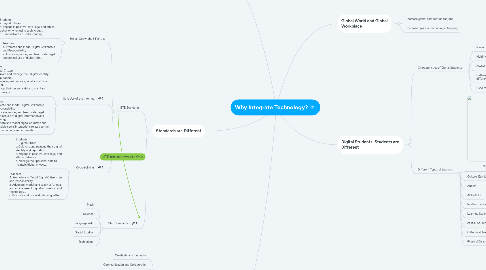
1. Teachers should be different: Teacher Preparation
1.1. Model appropriate technology use
1.2. Should have model of technology use in PTE (pre-service teacher education)
1.3. Universal Design for Learning (UDL)
1.3.1. 3 Principles
1.3.1.1. Multiple Means of Representation (What)
1.3.1.2. Multiple Means of Engagement (Why)
1.3.1.3. Multiple Means of Action and Expression (How)
1.3.2. Why is technology important to UDL?
1.3.2.1. Assistive Technology
1.3.2.2. Accessibility Technology
1.3.2.3. Online Resources
1.3.2.3.1. TechMatrix
1.3.2.3.2. Common Sense Media
2. Standards are Different
2.1. ISTE Standards
2.1.1. Ethics: Copyright & Fair Use
2.1.1.1. Students 2. Digital Citizen b. Engage in positive, safe, legal and ethical behavior when using technology... c. Demonstrate an understanding...
2.1.1.2. Teachers 4. Promote and Model Digital Citizenship and Responsibility a. Advocate, model, and teach safe, legal and ethical use of digital info...
2.1.2. Safe Use of the Internet
2.1.2.1. Student 2. Digital Citizen a. Cultivate and manage their digital identity and reputation... b. Engage in positive, safe, legal and ethical behavior... d. Manage their personal data to maintain digital privacy...
2.1.2.2. Teachers 4. Promote and Model Digital Citizenship and Responsibility a. Advocate, model, and teach safe, legal and ethical use of digital information and technology... c. Promote and model digital etiquette and responsible social interactions related to the use of technology and information.
2.1.3. Cyberbullying
2.1.3.1. Students 2. Digital Citizen a. Cultivate and manage their digital identity and reputation... b. Engage in positive, safe, legal and ethical behavior... d. Manage their personal data to maintain digital privacy...
2.1.3.2. Teachers 4. Promote and Model Digital Citizenship and Responsibility a. Advocate, model, and teach safe, legal and ethical use of digital information and technology... c. Promote and model digital etiquette...
2.2. Ohio Standards
2.2.1. Math
2.2.2. Science
2.2.3. Language Arts
2.2.4. Social Studies
2.2.5. Technology
3. 21st Century Skills: Skills are Different
3.1. Creativity and Innovation
3.2. Communication and Collaboration
3.3. Research and Information Literacy
3.4. Critical Thinking
3.5. Nonlinear Thinking
3.5.1. Benefits of Multimedia
3.5.1.1. Student
3.5.1.1.1. Stimulates the Senses
3.5.1.1.2. Promotes Active Learning
3.5.1.1.3. Provides Practice in Learning 21st Century Skills
3.5.1.1.4. Offers Opportunities for Ethical Use of Technology
3.5.1.1.5. Enhances Nonlinear Thinking
3.5.1.2. Teachers
3.5.1.2.1. Helps Communicate Instruction
3.5.1.2.2. Provides Practice in Facilitating
3.6. Visual Literacy and Visual Thinking
3.7. Spatial Thinking
3.8. Digital Age Thinking
4. Global World and Global Workplace
4.1. Increase global competition for jobs
4.2. Increased pace of technology changing
5. Digital Students: Students are Different
5.1. Characteristics of Digital Students
5.1.1. Never been without the Internet
5.1.2. Multimedia inclined
5.1.3. Always connected
5.1.4. Gathering and processing information differently
5.1.5. Used to a stimulating environment
5.2. Different Types of Learners
5.2.1. Multiple Intelligence's
5.2.2. Culture, Ethnicity, Languages
5.2.3. Autism
5.2.4. ADD/ADHD
5.2.5. Intellectual and Learning Disabilities
5.2.6. Learning Styles
5.2.7. At Risk Students
5.2.8. Gifted and Talented Students
5.2.9. Physical Disabilities

